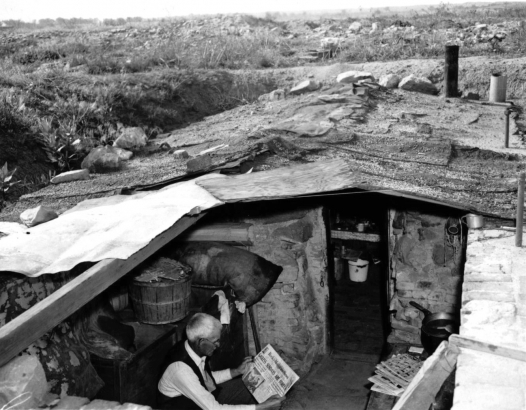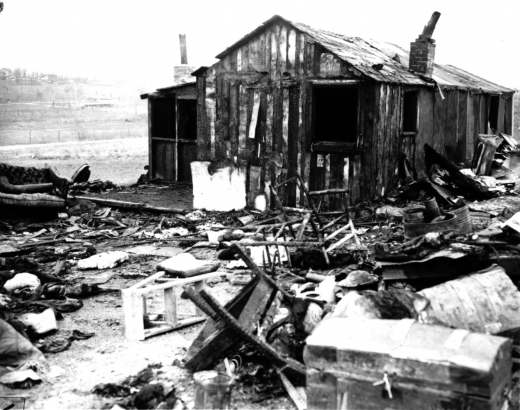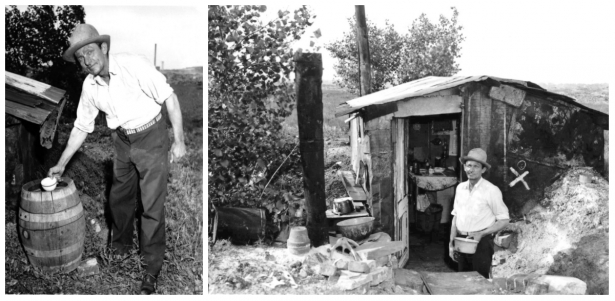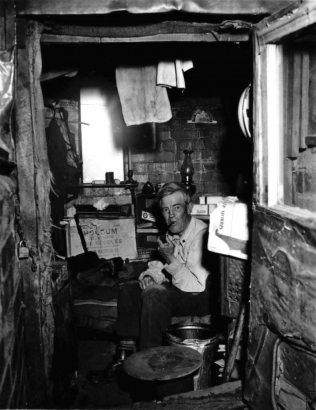If you set foot in Gopher City in 1941, you probably would have met Blackie, Dutch, Clarence, Johnny, Dipsy and Shorty.
But chances are quite good you wouldn't have casually come across Gopher City.
The reason? This Depression-era community (population: 6) was located in a garbage dump on Denver's Argo Hill.
When the Rocky Mountain News did a feature on Gopher City in 1941, they described its location as:
"...bounded on the north by the Burlington Shops, on the south by Denver Fire Clay brickyards and on the east by the railroad tracks. Roughly, the address is W. 47th Ave. and Delaware St."
The residents of Gopher City made homes that were:
". . . one-third bricked-in cave, one-third ingenious walls of stone and wood and tin, and one-third roofs of corrugated iron, tar, paper scraps, earth and sprouting Russian Thistle."
Resident Johnny Green, a part-time ash hauler who had lived in Gopher City for two years by 1941, remarked,
"The first guys out here dug the old bricks out of the smelter's foundations. They sold some of them and used the rest of 'em to line the walls of the shacks."
The homes in Gopher City went without gas, electricity and telephones (although Johnny owned a crystal radio set). Residents relied on resourcefulness to get by. Shorty kept an old beer keg to collect rainwater for washing dishes and clothes. Firewood and furniture were gathered from the dump to warm and furnish homes.
None of Gopher City's six residents were on relief at the time of the article, although some had obtained short-term employment through the Works Progress Administration (WPA). Resident Ben Lawton, known as "Dipsy," worked as a laborer all of his life, was blind in one eye, and once had a poem published in the Cheyenne Leader. He spoke to Rocky Mountain News reporter Robert L. Perkin about his reluctance to go on county aid and outsiders' perceptions of Gopher City:
"It's not that we aren't friendly out here—we just don't want people coming around oozing pity at us. We get along fairly well out here by ourselves. . . . We make ends meet—how we do it, so long as we do it legally, is nobody's business."
What became of Gopher City? It disappeared when Interstate 70 was constructed in the mid-1960s.
What happened to the residents of Gopher City? It is hard to know as most of the men were known only by their nicknames, with the exception of Johnny (Johnny Green) and Dipsy (Ben Lawton). Full names for Blackie, Dutch, Clarence, and Shorty were not mentioned in the 1941 article.
Johnny explained to the reporter about the use of nicknames at Gopher City,
"What's the difference? When a man ain't got no family, he just naturally don't need a last name."
If you like these historical stories, make sure to sign up for our newsletters and our WHG Facebook page!






Comments
Undoubtedly got the idea from
Undoubtedly got the idea from Hobbiton.
Perhaps, C. Root, perhaps.
Perhaps, C. Root, perhaps.
Thank you for this post—I'd
Thank you for this post—I'd never heard of Gopher City before!
Not to detract from the informative history presented here, but I must mention: It's rather odd to view digital images "from the WHG Undigitized Photo files"...
Perhaps a more enduring designation is in order?
Thanks for reading, David!
Thanks for reading, David! You've made an astute observation about "WHG Undigitized Photos!"
Note that the images in this blog post, although scanned, have not yet been cataloged/do not appear in the DPL Digital Collections. You may want to check out our Undigitized Photo Index, an alphabetical list of folder titles in the Denver Public Library's Western History Photograph collection arranged by subject: People, States, Towns and Countries, General Subjects, Railroad Companies, and Denver. The images in these folders have not yet been digitized and cataloged and can be viewed by visiting the Western History and Genealogy Department (Central Library, 5th Floor).
Loved the article Katie.
Loved the article Katie. Thank you for telling me about it!
Thank you for reading, Jim!
Thank you for reading, Jim!
What a fascinating story.
What a fascinating story. How resourceful those guys were! It's a shame they can't be traced!
Thanks for reading, Suzanne!
Thanks for reading, Suzanne! Perhaps further research conducted using WHG's genealogy resources could reveal more about these fellows. I found Ben Lawton, for example, in the 1930 U.S. Census on Ancestry Library Edition (available on all DPL computers). He was a staying as a lodger at 1322 16th Street in Denver. His occupation was listed as "laborer" in the industry of "odd jobs."
Add new comment